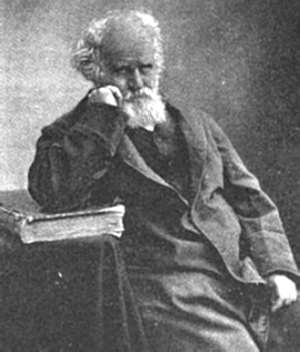 (source)
(source)
|
Pierre Janssen
(22 Feb 1824 - 23 Dec 1907)
French astronomer who made the first photographs of the granular structure of the Sun's surface, and studied its spectrum
|
The Observatory On Top Of Mont Blanc
UNDER WHAT DIFFICULTIES IT WAS ERECTED—
WHAT GREAT PROBLEMS IN ASTRONOMY IT IS LIKELY TO SOLVE.
by Ida M. Tarbell
From McClure's Magazine (1894)
[p. 289] FORTY minutes down the Seine from the centre of Paris, by a bateau-mouche, lands one at Bas-Meudon. A quick climb by a “funicular,” and you are at the foot of one of the most magnificent linden avenues in France. The quadruple row mounts a gentle slope to a broad terrace. Leaning over the balustrade one has a wonderful panorama stretching from right to left—Paris, with towers, domes, spires, and arches; the Seine, with its bridges and boats; the rolling country south ; and, in the near foreground, a forest and a village.Avenue, terrace, and forest belong to one of the historic properties of France—a property whose chateaux came from the hands of Philibert Delorme and Mansard; whose gardens were laid out by Le Notre; whose occupants have been from among all that was royal and gay in the French court since the days when François I. went there to visit the Duchess d'Étampes; whose forest is alive with memories of Rabelais and Madame Roland; and within whose boundaries, during the Revolution, was situated the famous tannery of human skins, and, during the siege of Paris in 1870, were camped the Prussians.
All these historical souvenirs are dimmed by the fame of the present master, and all the brilliant and tragic events which have centred about the old chateaux are of little import compared to the daily work now going on there. Since 1876, the chateau of Meudon, left in ruins by the Prussians, has had its walls patched with rough red bricks, its open roof topped by a mammoth dome, and has been used as an observatory by the eminent French astronomer Janssen, and the remnant of the ancient lodge has been his home.
Meudon has, however, a still nearer interest for us here than the fact that it is the home and, in a sense, the monument of M. Janssen. It is the birthplace of the investigations which have led to one of the most extraordinary undertakings of this generation—the erection of an observatory at the summit of Mt. Blanc.
It was a ray of sunlight that led the way, as a little look at the principles which M. Janssen has been following in his investigations will show.
IMPORTANCE OF LEARNING THE TRUE COMPOSITION OF THE SUN'S ATMOSPHERE.
If one looks at a ray of sunlight passed through a spectroscope, he sees that the spectrum is marked by a great number of dark lines. And a scientist will tell him that, whenever a beam of light passes through a gas, certain of its rays are absorbed, and that the spectrum of the beam shows, in the place of the absorbed rays, certain dark lines. The scientist will tell him, also, that each element in a gaseous state produces a spectrum peculiar to itself, and which shows itself, in the spectrum of a ray of light passed through it, in an invariable position, and by a characteristic system of lines. From these facts it is evident that, if an observer knew the spectra of all elements, he could tell at once the gases of what substances—that is, the kind of atmosphere—his ray of solar light had passed through. But a ray of solar light [p.290] passes through two atmospheres, that of the sun and that of the earth. Does the latter influence the spectrum? If it does, it is clear that we cannot decide on the nature of the sun's atmosphere until we have cancelled the influence of the terrestrial atmosphere from the spectrum.
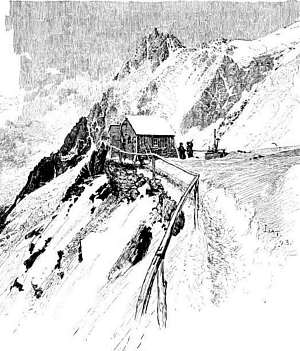
It was as many as thirty years ago that M. Janssen began to ponder this problem, and set himself the task of studying the spectra of the gases and vapors which form the earth's atmosphere, in order to find out what part, if any, they play in the solar spectrum. These investigations have far-reaching consequences. They look beyond the sun, and apply to all planetary and stellar bodies. They are the starting points from which to carry on all researches on the atmospheres of the planets, the nature of which must be known before it will be possible to say if these bodies can support life. When M. Janssen proposed to study the spectra of the gases in the earth's atmospheres he had begun to study the question of the ages : “Are the planets inhabited?”
It was not until 1885, however, that the particular investigations which interest us here began at Meudon. In that year the apparatus necessary to study various gases was put up, and M. Janssen began his work. His attention was soon turned almost exclusively to oxygen. In 1886 he announced that this gas shows itself in the spectrum of a ray of light passed through it, by a system of fine lines and bands which are not easily resolved.
A year later he announced the laws which control the phenomena of absorption in oxygen. These laws are such that the spectrum shows sometimes the lines, sometimes the bands, sometimes both. When M. Janssen interrogated the solar spectrum for oxygen, he found the characteristic lines and bands. Where did they come from? Undoubtedly, a part from the earth's atmosphere. But did any part of them originate in the sun's atmosphere? The question was serious.
Science has predicted that one day the fires of the sun will cool. As this cooling process goes on, the temperature of the envelope of the body will be affected. This latter contains, we know, great quantities of hydrogen. If, at the same time, it contains oxygen, necessarily, when a certain point has been reached in the reduction of the temperature, the two gases will unite and form vapor. A greater disaster to our solar system than a screen of vapor about the sun could not be imagined. In this fog the heat of the sun's rays would be absorbed, and the death of the planets from cold greatly hastened. Certainly, there is no danger of a speedy realization of this desolate fate. But science is neither personal nor selfish. The coming ages interest her as much as the present.
M. Janssen resolved to find out if this lot was awaiting the earth; if her future was to be cut short by a veil of vapor. That is, he resolved to find out the origin of the oxygen lines in the solar spectrum. But how could it be done? “How separate the certain action of the terrestrial atmosphere from the hypothetical action of the solar atmosphere?”
There was one evident method. If he could reach the limit of the earth’s atmosphere, and there examine the solar spectrum, the question could be solved at once. If the spectrum there was free from oxygen marks, why, then, those observed at the surface were due to absorption as the ray passed through the earth's atmosphere.
Not being able to reach this limit, M. Janssen decided to ascend as high as possible above the earth's surface for observation. If he found that the lines grew paler, or disappeared, and that the degree of the diminution in intensity and in number corresponded to the difference in the quantity of oxygen in the earth's atmosphere at and below the point of observation, then he would be justified in concluding that, in reaching the limits of the envelope (the earth's atmosphere), all the lines would disappear from the spectrum, and that, consequently, the atmosphere of the sun contained no oxygen.
It was in October, 1888, that the first experiment was made. The place chosen was the station on the route to [p.291] the summit of Mt. Blanc called the Grand Mulets, ten thousand and seven feet above sea level. The difficulty of making this ascent so late in the season—the refuge at the Grands Mulets was already closed, and quantities of snow had fallen—was great for any one but an experienced Alpinist. But M. Janssen is not easily baffled. He called a company of picked guides, and laid out a campaign which resulted successfully, the party reaching the staton after thirteen hours of toil, over a road which in the season does not require more than four or five.
If the ascent had been more severe, the reward was more than a compensation. The weather proved to be favorable, and M. Janssen succeeded in making a series of experiments which led him to [p.292] announce to the Academy of Science: “The lines and bands of the spectrum due to oxygen result exclusively from the earth's atmosphere. The solar atmosphere has nothing to do with the phenomenon. It is exclusively telluric.” Certain as the astronomer was of the conclusion, he was not satisfied. There was another experiment which could be made, and which would be still more complete. This was to make the observations in the ray on top of Mt. Blanc.
M. JANSSEN'S HARDIHOOD IN BEHALF OF SCIENCE.
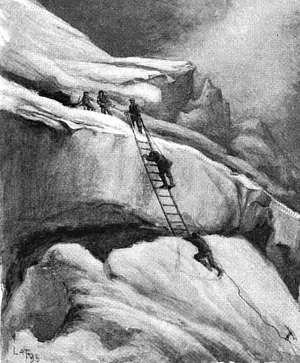
To see M. Janssen, a little man of nearly seventy years of age, with a halt in his gait, going about in his library, where piles of books and pamphlets, astronomical contrivances and celestial photographs hide him half of the time from view, one would not at first admit the possibility of his living through so dangerous and exhausting an expedition as the ascent of Mt. Blanc. It is only when one remarks the freshness of his face, half-hid under the abundant snowy hair and beard, the brightness of his eye, and the youthfulness of his voice, that one sees the real vigor and intrepidity of the man. A glance at the map of the expeditions he has made, reconciles one still further to the idea. His life has, in fact, been filled by a succession of hazardous and daring scientific undertakings. He has hunted the magnetic equator in the forests of South America; ascended the Himalayas; and descended into the crater of Kilauea, where, alone, during an eruption, he remained a night, making observations. He has braved heat and cold, earthquake and tempest. One of the pluckiest of his undertakings, and one which serves, perhaps, as well as any, to show his resolution and his independence, as well as his devotion to science, is a balloon ascent made in 1870. In December of that year, an eclipse took place, visible in Algeria. M. Janssen had been appointed to observe it. But he was in Paris, and Paris was in a state of siege. Unwilling to resign his mission, and too proud to ask a favor of the enemy, he left the city December 2d in a balloon. In five hours he landed a hundred leagues away. When he reached his post he learned that the English astronomers had asked that he be allowed to leave the city, and that the Prussians were about to grant the permission.
Only such a record is sufficient to explain his ascent of Mt. Blanc in 1890. At first, as he confesses himself, the difficulties seemed insurmountable. The trip to the Grands Mulets had fatigued him seriously. Could he mount five thousand seven hundred and twenty-three feet higher, by a path which requires two or three times as great effort, and in an atmosphere of increasing rarity?” There are very few things that cannot be overcome by [p.293] a strong will and profound study,” says M. Janssen. He made up his mind to go, and set himself to solving the difficulties. To begin with, he gave up the idea of ascending on foot. He wanted to save his strength for mental effort at the summit. In 1888 he had been carried up in a chair hung from the centre of a long ladder, the ends of which were placed on the shoulders of the guides. The result had been very good; but M. Janssen did not care to trust himself to this swinging chair over the perpendicular cliffs of the upper steeps. A new vehicle was necessary. He decided on a species of Lapland sled, to which should be attached rope ladders long enough not to interfere with the movements of the guides.
But the difficulty of finding some one to draw the ingenious contrivance was not a small matter. The guides of Chamouni are autocrats in their way, and do not often tolerate the ideas of climbers who are not Alpinists. However, the success of M. Janssen's chair, in 1888, had impressed them, and at last the astronomer succeeded in enlisting a sufficient number to attempt the ascent.
The party—twenty-two guides had joined it—started out on August 17. The sled worked perfectly. It is true it stood sometimes on one runner, the other being on the shoulders of the guides; it ran along ridges narrower than itself; it mounted pitches at frightful angles, but always with success, thanks to the courage of the guides, and the sang-froid and wise directions of the traveller.
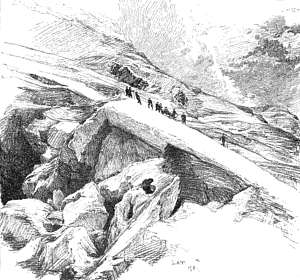
About one o'clock on the 18th the party reached the point known as the “Bosses,” about one thousand feet below the summit. The intention was to finish the trip the next day; but a terrible tempest arose that night, and it did not cease until the 21st. During two days and three nights the wind beat the mountain with a violence equal, says M. Janssen, to that which he experienced in 1874, in the harbor of Hong-Kong, where he had conducted the French mission to observe the transit of Venus—a typhoon which, it will be remembered, destroyed a part of the city and ravaged the China Sea.
When the storm was over, ten of the guides left, worn out by stay in the cabin, and skeptical, too, of the possibility of hoisting a man on a sled, and a quantity of delicate instruments, up the remaining steeps— the most difficult and treacherous part of the ascent. M. Janssen harangued his “twelve apostles,” as he dubbed the remaining guides, and the party started. It was a dizzy climb, but the last obstacle was passed finally, and the summit of Mt. Blanc came under the possession of science.
“I cannot express the emotion,” says M. Janssen, “which seized me when, the summit gained, my eye embraced the immense circle which unrolled around me.
“The weather was perfect, the purity of the atmosphere such that my eye reached to the bottom of the most distant valleys. The far horizon alone was veiled by a light fog. I had under my eyes all the southeast of France, the north of Italy and the Apennines, [p.294] Switzerland, with its sea of mountains and glaciers.
“Hills, valleys, plains, cities, in the immense thickness of the atmosphere which separated them from me, gave me the impression of a world lying at the bottom of an immense ocean of celestial blue water. It seemed to me that I heard the noises and movements which rose from below, and came to die at my feet.
“When my eye left these distant marvels, and turned to the scene near me, the contrast was striking. It was a world of glaciers, of ragged peaks, of white precipices, where a loud silence reigned. I fancied myself in the midst of one of those scenes which we can imagine on the earth when she shall have grown old, when the cold shall have driven away her life, and the profound silence of the end shall reign upon her frozen face.”
All the time that it was safe to remain in this high spot unsheltered, the astronomer spent in observation. The report of the expedition was made to the Academy of Science on September 22, 1890. M. Janssen declared, in regard to the solar spectrum, that his observations completed and confirmed those he had commenced two years before, at the station of the Grands Mulets, and showed that there is no oxygen in the gaseous envelope which surmounts the photosphere; at least no oxygen with a constitution which allows it to exercise on light the phenomena of absorption which it produces in our atmosphere.
But he announced other conclusions: that intellectual work is by no means impossible in high stations, upon condition that one makes no physical effort in getting there; and that, in his judgment, there would be an interest of the first order for physical astronomy, for terrestrial physics, and for meteorology, in establishing an observatory at or near the summit of Mt. Blanc.
“I know,” said M. Janssen, “that it will be said that the difficulty of building such an edifice on so elevated a summit is great; that one can get there only by severe effort; that violent tempests often rage there. All these obstacles are real, but not unconquerable.
At least, such is my opinion after a careful study of the question, and after having made the ascent.”
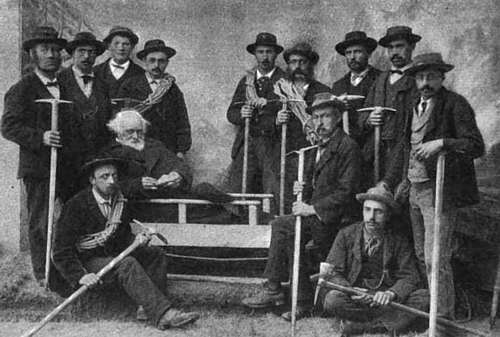
It must not be supposed that M. Janssen's idea of the value of an elevated astronomical station was founded only on his observations on Mt. Blanc. In his life as an astronomer, he has had frequent opportunities of testing the advantages of high stations. In 1864 he had passed eight days at the summit of the Faulhorn, studying the action of the earth's atmosphere in the rays of the solar spectrum. In 1867 he had worked on Etna and the Picdes Acores. In 1868 he observed the eclipse of that year on the Himalayas. In 1871 he was at Schooler, in the Neilgherry Hills, India, for the eclipse of the 12th of December. The remarkable results of these expeditions, particularly of the last two (in that of 1868 he had discovered the nature of the solar protuberances, as well as a method of studying them; and in that of 1871 the existence of that vast gaseous atmosphere of the sun which, at the time of a total eclipse, produces the magnificent corona) had convinced M. Janssen that elevated astronomical stations would be of the greatest service to astronomy. This conviction had been confirmed largely by the success of American astronomers in observing the eclipse of 1878 from high elevations.
The report made to the Academy received immediate response. M. Bischoffsheim of the observatory of Nice, Prince Roland Bonaparte, the Baron de Rothschild, and M. Eiffel offered their aid to the energetic scientist in establishing an observatory on Mt. Blanc. Thus supported he began his plans at once.
SEEKING A SITE FOR THE MT. BLANC OBSERVATORY.
The first concern was to search the solid rock for a foundation. The depth of the snow and ice at the summit was unknown, but the general opinion was that it was not great. M. Imfield, a Swiss engineer, was charged with the mission of searching the rock, the difficulties and dangers of which search are apparent. In August, 1891, the engineer [p.295] began to run a horizontal gallery into the snow, at about forty feet below the summit. This gallery was continued from north to south for some seventy feet. But no rock, nor real ics in fact, was found; nothing but a hardened snow. Now, as the head of Mt. Blanc is narrow from north to south, but some three hundred feet long from east to west, it was decided to run a gallery from east to west, beginning it at the end of the first one. This was done to the length of seventy feet, and still no rock.
M. Janssen was not surprised at the result. It was possible that the cover-lid of snow was over forty feet in thickness; or that, if it was not, the gallery had passed between two needles. But since he had not found the rock, he changed his plan, and proposed to build his house on snow. The idea was bold, but reflection convinced him that it was practicable. There were three important questions to settle. Did the snow undergo movements which would carry off a structure placed upon it? Would its resistance be sufficient to support so great a weight? Could there be a means devised to prevent [p.296] the winds from picking up the observatory and transporting it into another country? After having studied the descriptions of the summit given by early Alpinists, and after having talked with the guides familiar with the mountain, M. Janssen concluded that there was but little movement of the cover-lid; and that, if any did take place, it was of a glacier-like slowness, and could be easily counteracted.
To settle the question of the resistance of the snow, he made an interesting experiment. Says he, “ During the winter I piled up, in one of the courts at Meudon, as high as the first story, a little mountain of snow. It was packed so as to give it the same density as that which covers Mt. Blanc at a depth of from four to six feet. The summit having been levelled, disks of lead of a diameter of thirty-five centimeters, and weighing about eighty-four pounds each, were placed upon it. The first one scarcely made an imprint. The column was raised until it contained twelve disks, a weight of one thousand and eight pounds. When they were taken off and the imprint measured, it was found to be seven to eight millimeters deep. The gardeners who had done the work would scarcely believe their eyes. This high column of lead rising slowly, without seeming to make any impression on the snow, seemed to be held there by some magic power.”
Basing his calculations on this experiment, M. Janssen decided that the resistance of the snow at the summit was sufficient to allow him to put up the building.
To resist the storms, he decided to give the house the shape of a quadrangular, truncated pyramid, and to bury three-fourths of the lower story in the snow. This form would give a considerable base; all the surrounding snow would tend to hold it in place, and the inclination of the exposed walls would “shed” the wind and diminish its effects.
To make a beginning, he had a little cabin erected at the summit in 1891. Four months after it was put up, in January, 1892, it was visited, and found not to have changed its position materially. The snow without had not changed level sensibly, and there was no snow within. This was a strong confirmation of M. Janssen's theories, and he proceeded to the construction of the observatory itself.
HOW THE OBSERVATORV WAS BUILT AND ERECTED.
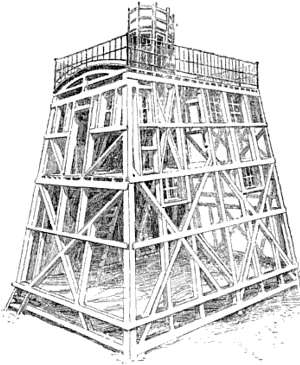
The structure was prepared at Meudon under M. Janssen's eyes. It is two stories high, with a terrace. The rectangular base is about thirty-three feet long by fifteen feet wide. A spiral staircase runs the height of the building, and unites the two stories and the terrace, which is raised several feet and supports a platform intended for meteorological observations. The walls, windows, and doors are double. Care was taken to knit the parts of the structure in such a way that the whole would be rigid, and would support putting back into place, in case a movement of the snow carried it out. Particular attention was given also to make the structure light, as well as rigid, in order to lessen the difficulty of mounting it to the top.
In 1892 the observatory was shipped to Chamouni. All told it weighed about fifteen tons, and, when put up in loads which could be carried on a man's back, it was found that there were seven or eight hundred of them. During the summer of 1892, the workmen succeeded in getting a quarter of this material to the Grand Rocher Rouge, three thousand feet below the summit, and the rest to the Grands Millets. In the summer of 1893 the work was to be completed.
When the season opened, and the workmen went about their tasks, the first inspection of the stores at the Grand Rocher Rouge showed that a large part of the supplies had disappeared. There was general consternation, for not an accident, scarcely a faux pas, had happened in the five years’ work. The supplies were found, however, buried some thirty feet beneath the snow. All through the season long lines of workmen crawled like spiders over the glassy upper steeps of the mountain, hoisting by an [p.297] ingenious system of pulleys and cranes the materials for the observatory.
When every thing was on the spot, the carpenters were sent to the top to put the building together. By a happy chance they had fifteen days of absolutely calm weather, and by the 8th of September, 1893, the observatory was in place—walls standing, floors laid, staircase up, windows in; all done, in short, but a part of the terrace. Impatient to see the new work, M. Janssen hastened to the summit. It was the 11th of September that he reached the new building, which, upon inspection, he found entirely satisfactory, with one exception. It was not as deeply buried in the snow as he had ordered. This defect, M. Janssen tells me, he hopes to have repaired.
Eager to begin work in the new observatory, the astronomer sent his guides back to the Grand Rocher Rouge, where the provisions and instruments had been left, with orders to bring up the latter first. The order was obeyed; but, unhappily, the men had only reached the observatory when the weather changed, and the party remained two days away from their food supplies.
In spite of the discomfort caused by [p.298] this misfortune, M. Janssen found himself in good working condition when the storm cleared away and he could go about his observations. Indeed, all his faculties seemed to be quickened, and he speaks with something like awe of the distinctness of the impressions made upon him by a sunset of great grandeur which occurred after the storm had ceased.
“Why,” asks he, “ were my emotions so intense? Why, particularly, during the four nights I spent at the summit, did I experience a sensation of delicious lightness throughout my being? Why did it seem to me that a burden which until then had chained and weighed down my mind was lifted, and that now I could grapple with the most difficult and the most delicate questions of a high moral kind, in full liberty and love?
“Was it simply the effect of the rarity of the air at these high altitudes? Did there not enter other causes still unknown, and which will be studied by-and-by?
“However it may be, it is clear that nature, who does nothing in vain, and who is full of harmonies, aims to prepare us, by the effect of these high altitudes, to feel more deeply the grandeur and the sublimity of the scenes which she presents us there.”
THE FIRST OBSERVATIONS.
The first observations made were naturally on the oxygen lines in the solar spectrum. This time M. Janssen used a spectroscope much superior to that used in the two former expeditions. The results confirmed those reached before. In one of the fine passages in which his reports abound, he says of this conclusion:
“This absence of gas in the atmosphere of our central star interests us not only from the point of view of the future of the worlds which belong to it; it has a bearing of a still higher order: it reveals a new harmony in its constitution.
“We know already the chief features of the sun's constitution and the admirable conditions which assure both the abundance and the duration of the radiation which it pours upon the planets which surround it. We know that this incandescent surface which surrounds the sun, and in which resides the power of radiation, regenerates itself from stores of heat in the central mass.
“We know that this radiating surface is protected from the contact of the ice-cold celestial spaces by several gaseous envelopes. Of these envelopes, or atmospheres, the highest, and doubtless the most efficient as protection, is the so-called corona. This atmosphere is principally formed of hydrogen, the lightest and most transparent of known gases. The essential function of radiation, which is the very reason for the existence of the central star, is thus assured by this transparent, protecting atmosphere. But we see now that by an admirable precaution, the body which, at a certain period in the sun's future, would have ruined this function, has been carefully kept out of it.
“It is thus that science, in measure, as it advances, reveals to us ceaselessly new laws and harmonies in the structure of the universe.”
WHAT IT IS HOPED TO DO AT THE HIGH OBSERVATORY.
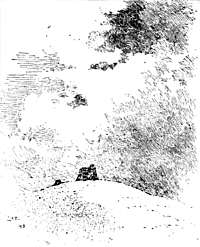
But it is not only to prove that there is no oxygen in the sun's atmosphere that the observatory has been erected on Mt. Blanc. A complete study of the envelope will be made from this new point of observation, and undoubtedly with great success, the interference from the gases and vapors which surround the earth being so largely annulled. Here, too, the chromosphere, the protuberances, the coronal atmosphere, will be studied with new facility.
Another question of vital importance to the comfort of the earth is that of the sun's radiation. Is it decreasing? If so, at what degree? Does it vary periodically like the sun's spots? On the top of Mt. Blanc all these questions will be studied with greater surety. Evidently at the earth's surface they are complicated on account of the vapors through which the rays [p.299] have passed, and which absorb, we know, quantities of the heat.
The earth, too, will be viewed from a new point. Here the terrestrial spectrum will be examined and photographed. Storms, clouds, thunder, lightning, all the phenomena of the earth's air, will be studied from above, instead of below. The “field” for the observer in this novel situation is of an immense extent; a view whose diameter is about three hundred miles, and which includes the sunny plains of Lombardy, long stretches of the basins of the Rhone and the Rhine, the snowy mountains of Central Switzerland, all Dauphind, the Jura, the Vosges. Below is an atmosphere two-and-a-half miles in depth. The observer can watch over all this vast expanse the formation, movements, and disappearance of clouds, and the effects upon them of pressure, damp, electricity. He can trace them from their birth in a distant valley in the blue ocean until they lie, a world of billows, between him and the earth below. Here he may unwind the cyclones and chain the lightnings.
But by far the most fascinating study that will be pursued at the new observatory has reference to the planets. Already M. Janssen has studied the atmospheres of several planets, from high stations, to discover if they contain water vapor. At the top of Mt. Etna, in 1867, he discovered the existence of vapor in the atmosphere of Mars, and was able to conclude that the seas whose outlines are designed on the surface of Mars are seas of water, and that the polar caps which [p.300] shine at times with extraordinary brilliancy, and which in their fluctuations follow the seasons of the planet, are of ice, similar to our polar seas. In the atmosphere of Saturn, he has also found vapor, and probably, too, in that of venus. From the top of Mt. Blanc this interrogation of the planets will go on. Listen to M. Janssen.
“Do I mean that astronomers will one day show you in their glasses the inhabitants of the planets? Certainly, no. There are difficulties to this direct solution which may be said to be insurmountable, and which do not depend upon the progress of optics. But science has other ways, slower, it is true, but quite as sure, and of considerable philosophical bearing. She makes a genuine siege of a place, and in such a way that it is obliged to capitulate without her making as assault. It is in the complete ensemble of astronomical, geological, physical, chemical, and biological conditions offered by the planets of the solar system that science will be able to say with certainty whether or no the planets are habitable.
“This great study is already far advanced. The astronomical conditions are known. They carry with them almost all geology, since chemical unity has been demonstrated by physical astronomy. But science, not satisfied with having shown the common origin of the planets; with having shown that they are globes like ours, possessing continents, seas, an atmosphere, satellites; not content with having demonstrated the identity of their substances, now turns her investigations on their atmospheres.
“The spectrum of water vapor has been discovered, which discovery has enabled us to show the presence of this element essential to life in the planetary atmospheres. The discoveries which have just been made on oxygen will permit us to search for the presence of this vital gas.
When these investigations are finished; when science shall have determined rigorously the astronomic conditions in which each planet is placed; when she shall have fixed the geological period, the chemical constitution, of the star, the nature of the gases which form [p.301] its atmosphere and that of the fluids which compose its oceans, then she will be able to say with certainty if the planets are habitable and what is the nature of the life they can support; for these are the points which determine the question.
“It is a fine problem that we are on the point of solving: perhaps the highest that human intelligence has ever proposed.”
It is a fine problem and an inspiring one. But still more inspiring is it to trace the paths which are leading to its solution ; to see how, as in the case of the researches of M. Janssen, a question raised over thirty years ago, and followed persistently—sometimes interrupted for years, perhaps, by other work, sometimes delayed by lack of apparatus, yet always kept in sight— becomes at last so freighted with data, so important in the eyes of the world, that everything else is forced aside to give it place, and the aid of all the scientific world offered to hasten its solution ; to see how after years the aloe blooms.
Still more inspiring is it to see how the solution of one question suggests that of others; how the means necessary for one can be utilized for others; how surely human knowledge rises by the patient persistence of men in answering the one question which has come to them with particular force, and for which science so far has had no answer. The observatory on Mt. Blanc, and all the possibilities it offers, is the direct result of such steadfast devotion.
- 22 Feb - short biography, births, deaths and events on date of Janssen's birth.
- The Astronomer Jules Janssen: A Globetrotter of Celestial Physics, by Françoise Launay. - book suggestion.
